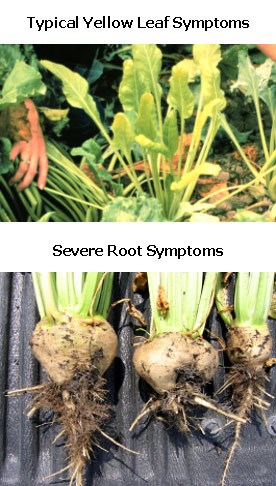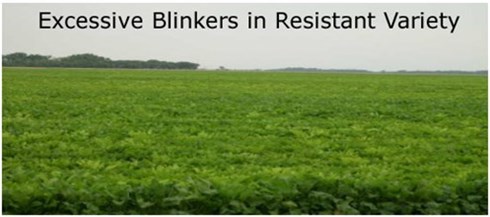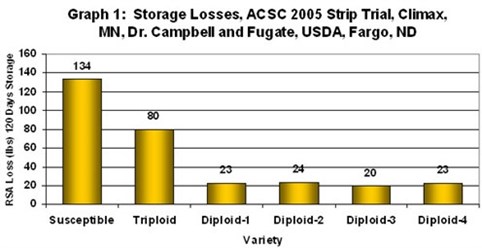536 - Root Disease Management: Rhizomania
The NDSU-UM Production Practice Survey asked the question "what is your most serious production problem since 1969." The answer 95% of the time was weeds. The answer after the 2009 crop year was root diseases. It would be very safe to predict that root rots will continue to be the most serious production problem for many years into the future. Over the next few months' four issues of the Ag Notes will focus on the root diseases Rhizomania, Rhizoctonia, Aphanomyces and Fusarium. Disease symptoms and identification and control options will be discussed. These disease problems cause millions of dollars in lost yield and additional millions in sugar losses in storage piles each year. This issue will focus on Rhizomania.
Rhizomania Symptoms

Typical foliar symptoms show up as yellow patches in the field and can be confused with poor nitrogen supply or water damage. In dry conditions plants may occasionally wilt in the field despite sufficient moisture.
About Rhizomania
- Rhizomania is a virus carried by a fungus
- Spread by infected soil and water movement
- Excess water and poor soil drainage enhances development and propagation
- Causes stunting of root
- Large number of small lateral roots
- Root may be small with dark veins or rot
- Vascular rings visibly darkened
- Leaves are thick and wilt easily in dry periods
- The infection will block moisture and nutrients from entering the beet
Economic Impact
Yield losses can be 25-50% loss in recoverable sugar per acre with susceptible varieties. Resistance breaking strains of the virus or very high inoculum levels can cause 10-20% loss, even with resistant varieties commonly grown in the Red River Valley. Sugar content can often drop 0.5-1.0% even in fields with acceptable to good yields when planted to resistant varieties.
Very High Inoculum/Resistance Breaking Strains
Rhizomania has been present in the Red River Valley for well over 10 years. Many fields have been documented with very high inoculum levels in the soil. Some fields have been identified that have resistance breaking strains of the virus.. Fields with "blinkers" like those in the picture below must be planted to varieties with higher resistance levels for Rhizomania. Contact your agriculturist to discuss where more highly resistant varieties are required.

Counties with very high inoculum or resistance breaking strains listed in order of severity: Polk, Norman, Clay, Grand Forks, Cass, Marshall, Walsh, Pembina, and Kittson
Rhizomania Control Measures
- Choose the correct level of varietal resistance for your fields.
- Early planting can reduce severity
- Improving field drainage lessens severity
- Longer crop rotations are beneficial
Sugar Losses in Storage
Rhizomania infected beets cause very serious losses of sugar in storage. Losses vary with inherent resistance level of each variety, Graph 1.

